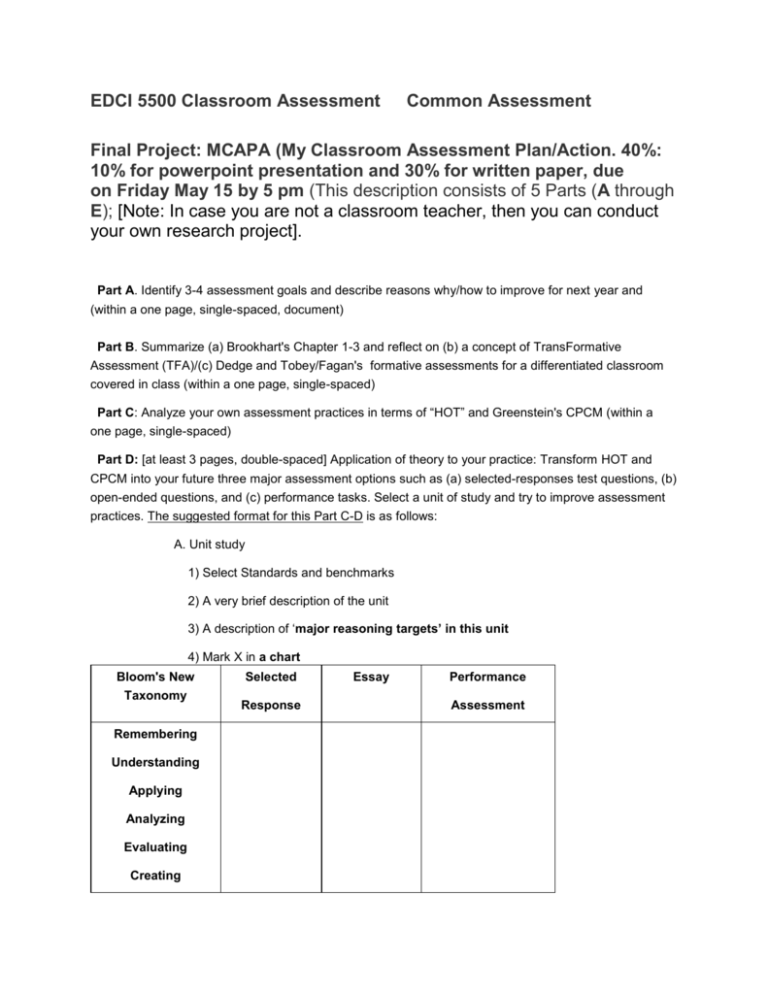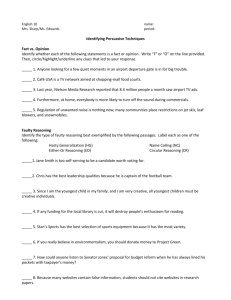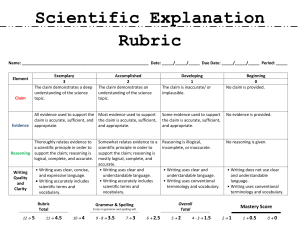EDCI 5500 Classroom Assessment
advertisement

EDCI 5500 Classroom Assessment Common Assessment Final Project: MCAPA (My Classroom Assessment Plan/Action. 40%: 10% for powerpoint presentation and 30% for written paper, due on Friday May 15 by 5 pm (This description consists of 5 Parts (A through E); [Note: In case you are not a classroom teacher, then you can conduct your own research project]. Part A. Identify 3-4 assessment goals and describe reasons why/how to improve for next year and (within a one page, single-spaced, document) Part B. Summarize (a) Brookhart's Chapter 1-3 and reflect on (b) a concept of TransFormative Assessment (TFA)/(c) Dedge and Tobey/Fagan's formative assessments for a differentiated classroom covered in class (within a one page, single-spaced) Part C: Analyze your own assessment practices in terms of “HOT” and Greenstein's CPCM (within a one page, single-spaced) Part D: [at least 3 pages, double-spaced] Application of theory to your practice: Transform HOT and CPCM into your future three major assessment options such as (a) selected-responses test questions, (b) open-ended questions, and (c) performance tasks. Select a unit of study and try to improve assessment practices. The suggested format for this Part C-D is as follows: A. Unit study 1) Select Standards and benchmarks 2) A very brief description of the unit 3) A description of ‘major reasoning targets’ in this unit 4) Mark X in a chart Bloom's New Taxonomy Remembering Understanding Applying Analyzing Evaluating Creating Selected Response Essay Performance Assessment 5) Explain each X mark specifically with “some representative sample items” in the context of your teaching and learning process. Do not simply repeat what you had done previously. Please do something new or different in an effort to make an improvement in your classroom. At this point, the instructor wants you to learn specific rules or principles of how to construct assessment methods based on materials in our textbook. Consider the following three questions: (a) How might you incorporate reasoning targets into your teaching? (b) What are some representative sample items? * The most important part! (you can focus on one of four assessment options in detail or you can go over all of four options in terms of the optimal effect) (c) What considerations should be made in terms of various needs of students? (d) Are there any validity, reliability, and practicality considerations? Part E: Develop your own rubric, rating scale, or check-list used for self-assessing your own MCAPA: the clarity of goals, the proper identification of learning targets and reasoning targets; valid and reliable assessment methods/tools; effective presentation. EDCI 5500 Final MCAPA Rubric Advanced Goals (Part A) Proficient Basic Below Basic * 3-4 assessment goals are * 3-4 assessment goals are * 2-3 assessment * Assessment goals clearly stated. and rationales are very generally stated. * The rationale of each goal is * The rationale of each goal explicitly discussed. is briefly discussed. goals are not only generally stated but also broad and irrelevant. vague. * Some rationales for goals are superficial. Synthesis of * Refers to all 3 Required texts substantially. Texts (Part B) Reasoning Targets (Part C) * Demonstrates deep and thorough understandings of ideas, concepts, and skills. * Demonstrates a thorough * Refers to all 3 texts * Refers to 2-3 * Refers to 1-2 texts with generally. texts synoptically or very weak * Demonstrates some deep superficially. understandings of ideas, * Shows shallow concepts, and skills. understandings of texts. * Demonstrates a general * Shows a brief analysis * No analysis of analysis of reasoning targets analysis of reasoning targets of reasoning targets. in reference with the text. in reference with the text. * All explanations of * A couple of reasoning Assessment Methods (Part D) reasoning targets. * Many reasoning targets are superficially reasoning targets are clearly targets is somewhat unclearly explained. Application summary/synthesis. * Reasoning targets are not explained. made. explained. * Illustrates a thorough * Illustrates a broad analysis * Shows a weak * No analysis of analysis of of standards/benchmarks. standards. standards/benchmarks. * Provides generally aligned * Provides ideas for each greatly articulated/aligned learning/reasoning target ideas for each learning and reasoning targets. * Uses a variety of assessment strategies and methods. analysis of standards. * Provides poorly aligned ideas * Uses a variety of for learning/reasoning assessment strategies and target methods. * Uses very limited assessment methods, and reliable assessment and methods, including items. methods, including sample unclear sample items items for measuring general with less emphasis reasoning targets. clear reasoning targets. * Shows no meaningful assessment strategies e.g., reliable assessment sample items for measuring learning targets. * Develops moderately valid * Develops highly valid and methods, including clear * No planned ideas of on reasoning skills. invalid sample Self- * Follows suggested format * Follows suggested format * Develops a set of Assessment in syllabus. Scoring Guide in syllabus. * Develops a set of highly * Develops a set of (Part E) accurate, meaningful accurate evaluative criteria evaluative criteria in the in the scoring guide. scoring guide. * The scoring guide is mostly inaccurate completely disorganized, evaluative criteria in invalid, and unreliable. the scoring guide.






